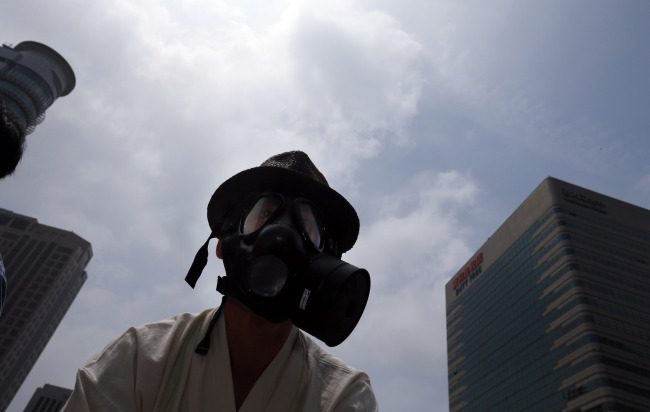About half of Korea’s fine dust particles originate from within the country, while one-third is from China, a study jointly conducted by a South Korean institute and NASA showed Wednesday.

According to the preliminary Korea US-Air Quality (KORUS AQ) study, conducted by NASA and Korea’s National Institute of Environmental Research, about 52 percent of Korea’s fine dust particles and other airborne pollutants have domestic origins. China was the origin of some 34 percent of the particles, while 9 percent came from North Korea.
The study was conducted between May and June, when the China factor is considered to be lower than during the winter and early spring.
A previous study by Yale and Greenpeace released in 2015 estimated that 50-70 percent of fine dust was domestically sourced.
“The impact of sources outside Korea varies greatly with season and requires further study, as much of the KORUS AQ study period was characterized by meteorology preventing direct transport from East Asia,” the report said.
James Crawford, lead scientist on the project, also said that the influence of domestic emissions was maximized when the observation took place last year.
“The meteorological conditions during the study were very favorable for understanding how local emissions contribute to the local air quality problems,” Crawford told The Korea Herald.
“But the actual conditions will be influenced by year-to-year differences in meteorology and seasonal differences in long-range transport (of molecules),” he said.
Park Jin-won, director of NIER, said the findings will help determine pollutants’ origin and understand what measures to take domestically to improve air quality, after decades of rapid industrial development and growth in coal-fired power plants here.
South Korea saw the worst air quality ever recorded between January and March this year, with the average concentration of PM 2.5 -- ultrafine particles less than 2.5 micrometers in diameter -- standing at a record 32 micrograms per cubic meter, much higher than the World Health Organization standard of 25 micrograms per cubic meter per day.
In 2016 Environmental Performance Index released by Yale University, South Korea ranked 173rd among 180 countries in terms of air quality. China ranked the bottom.
According to the preliminary analysis of the KORUS AQ study, ground level observations in Seoul showed that nitrates gas, which principally comes from motor vehicle exhaust – accounts for roughly half of the air particulate pollution.
More than half of PM 2.5 were composed of volatile organic compounds (VOCs) and black carbon (BC), very fine particles that can pass much more easily and deeply into the lungs and pose greater threat to respiratory systems.
The study also suggested that ozone concentrations can be attributed to the high volume of vehicles in metropolitan areas and emissions from chemical factories and coal-fired power plants in the southern region.
Citing an example of airborne observation near the Daesan chemical facility complex in South Chungcheong Province, the report said ozone concentration was 10 times higher there, with 25 different kinds of VOCs.
The province also has 26 of the country’s 59 coal-fired power plants.
More detailed observations are needed regarding these facilities to understand exposures for workers as well as people living and working nearby, researchers said in the report.
Ozone, which is created when pollutants react with each other and the air, can trigger several health problems, including chest pain, coughing and throat irritation.
Currently, the NIER issues an ozone advisory when the concentration hits 120 ppb for more than an hour. Seoul had ozone advisories issued on 29 days last year.
President Moon Jae-in had announced his vision for cleaner air by introducing a series of measures including stricter emissions tests for diesel vehicles and permanently closing old coal-fired power plants by the end of his term.
In that vein, last month, he ordered a stoppage of 10 coal-fired power plants that had been in operation for 32 to 44 years.
Coal has been highlighted as a source of fine dust, coupled with emissions and yellow dust originating from China.
The final report will be released in 2019.
By Kim Da-sol (ddd@heraldcorp.com)





![[Herald Interview] 'Amid aging population, Korea to invite more young professionals from overseas'](http://res.heraldm.com/phpwas/restmb_idxmake.php?idx=644&simg=/content/image/2024/04/24/20240424050844_0.jpg&u=20240424200058)












![[KH Explains] Korean shipbuilding stocks rally: Real growth or bubble?](http://res.heraldm.com/phpwas/restmb_idxmake.php?idx=652&simg=/content/image/2024/04/25/20240425050656_0.jpg&u=)

